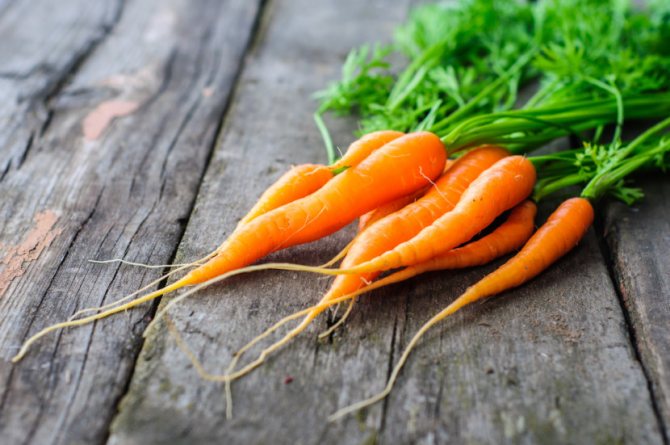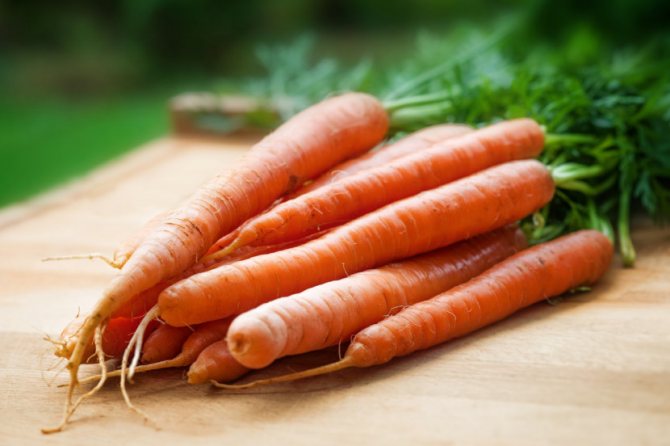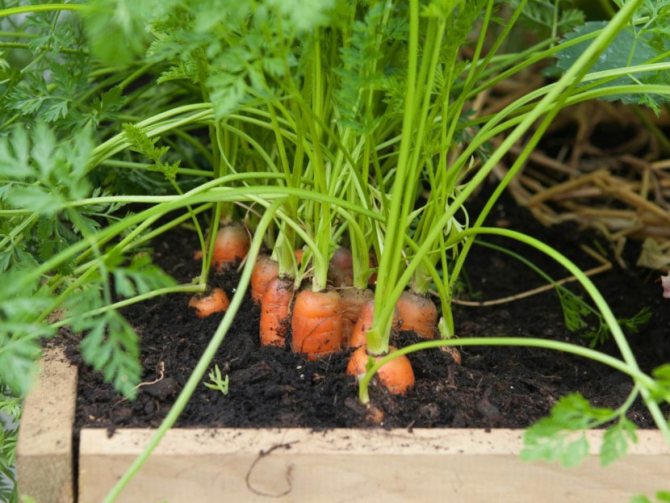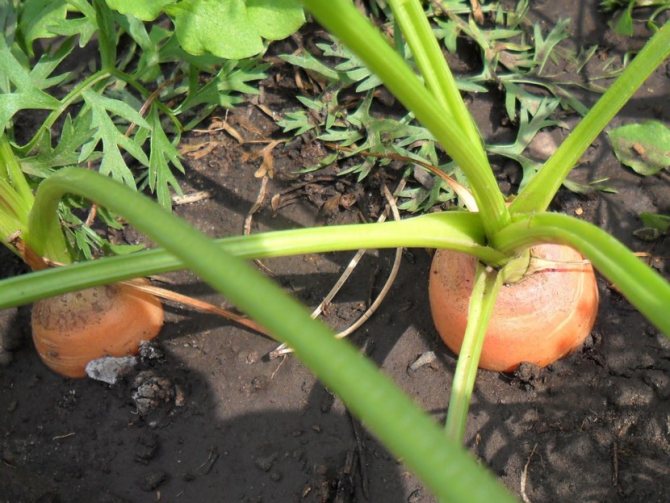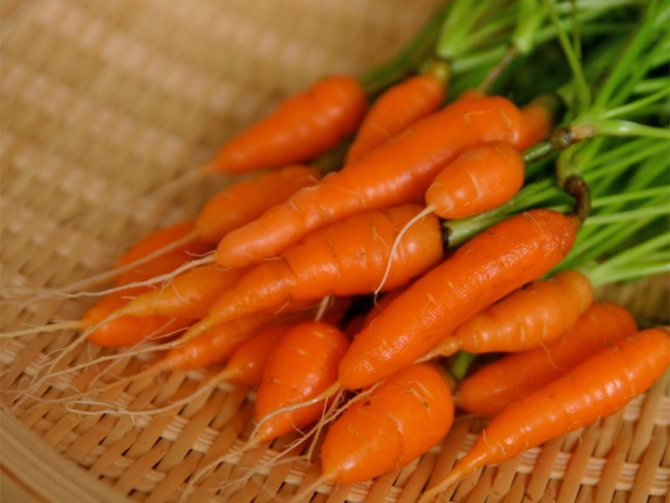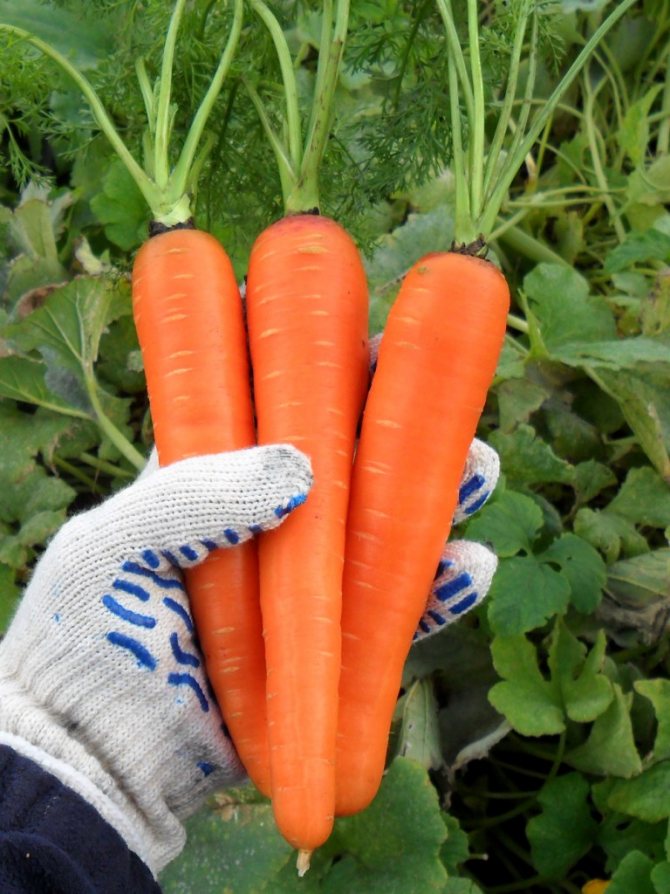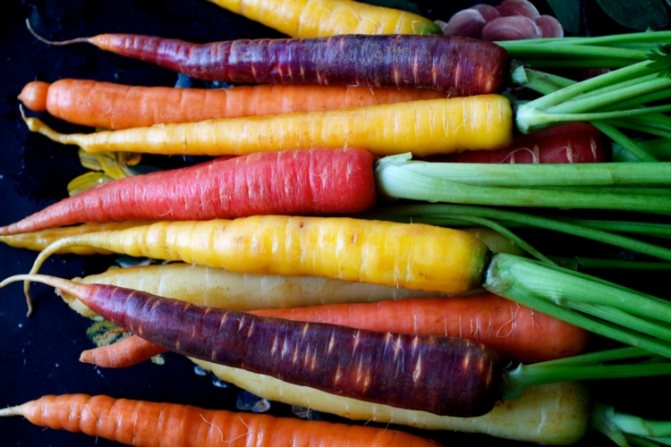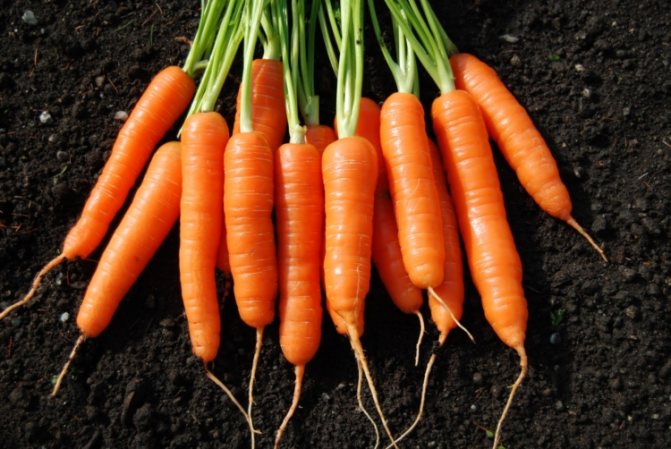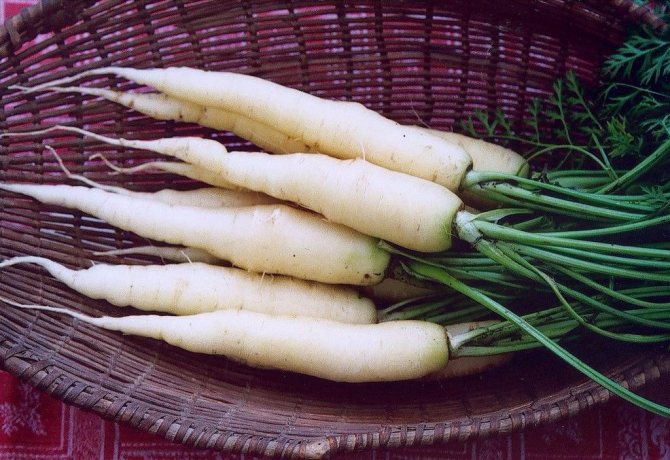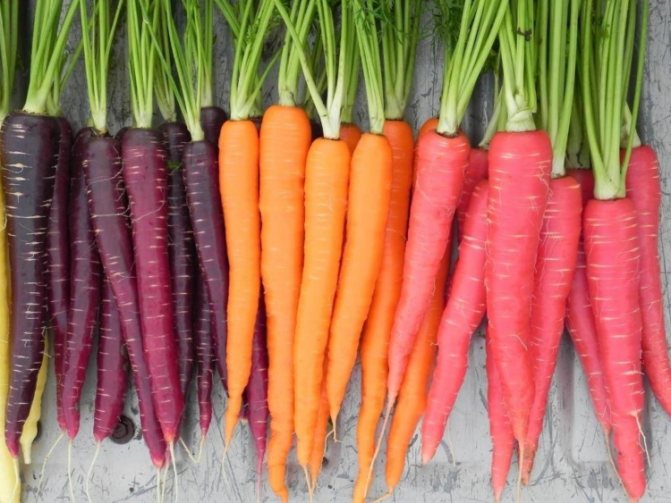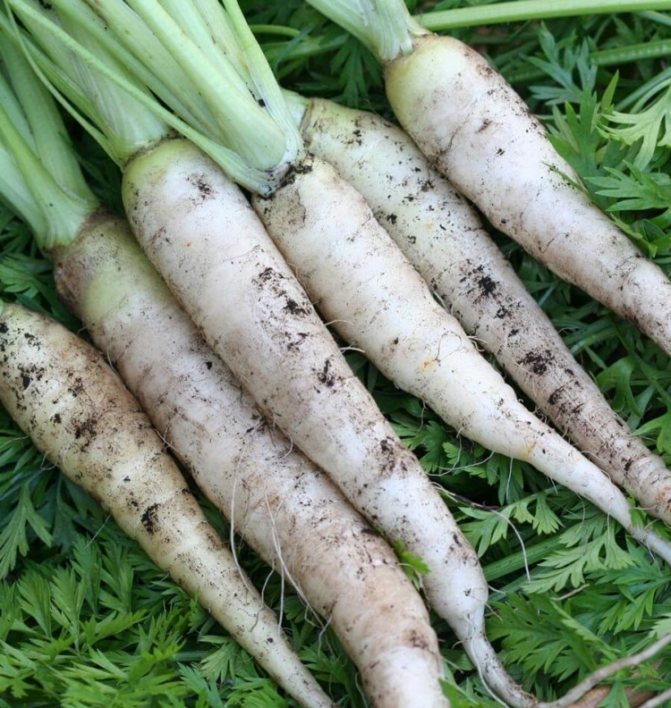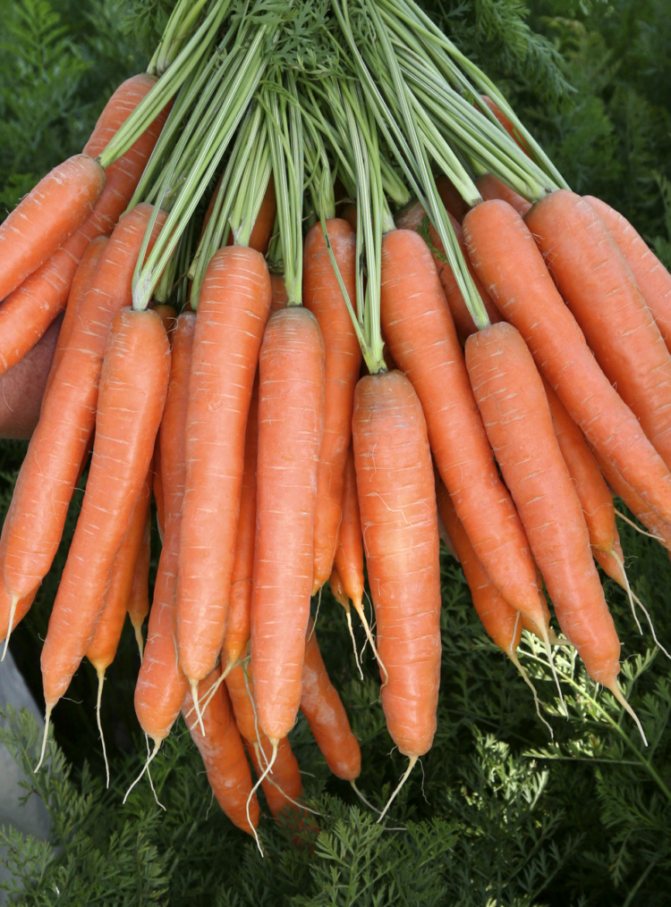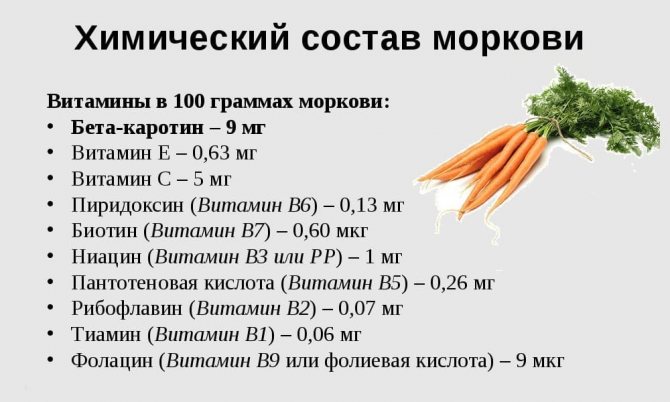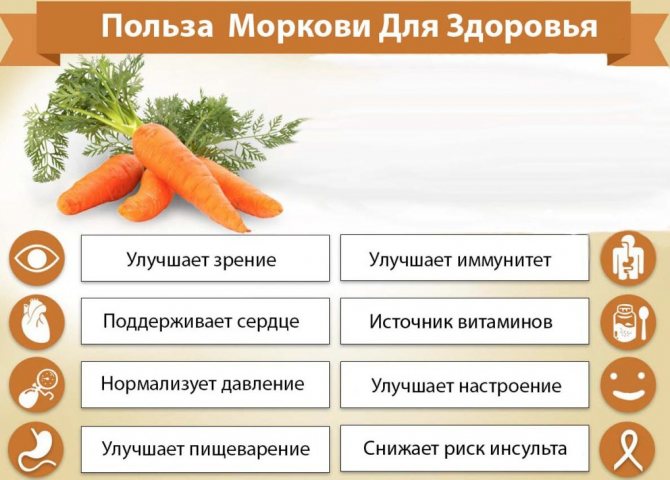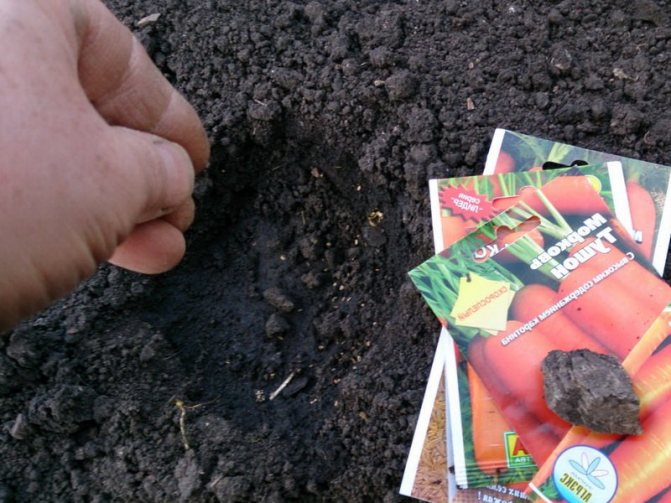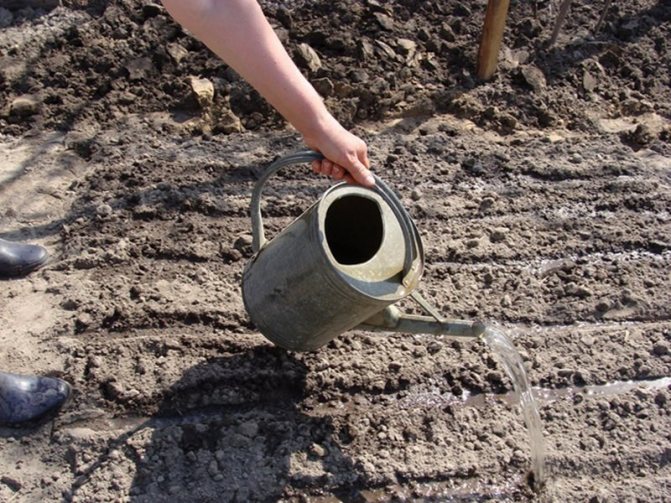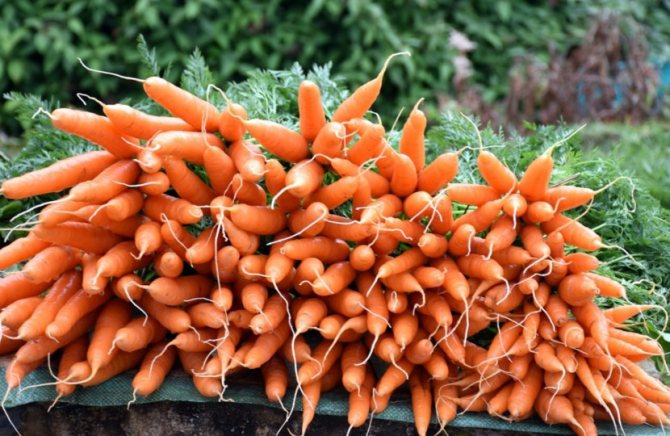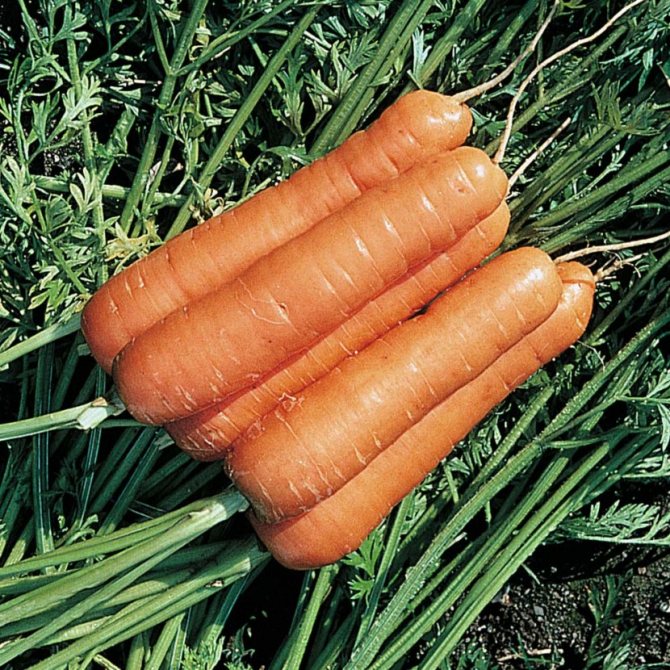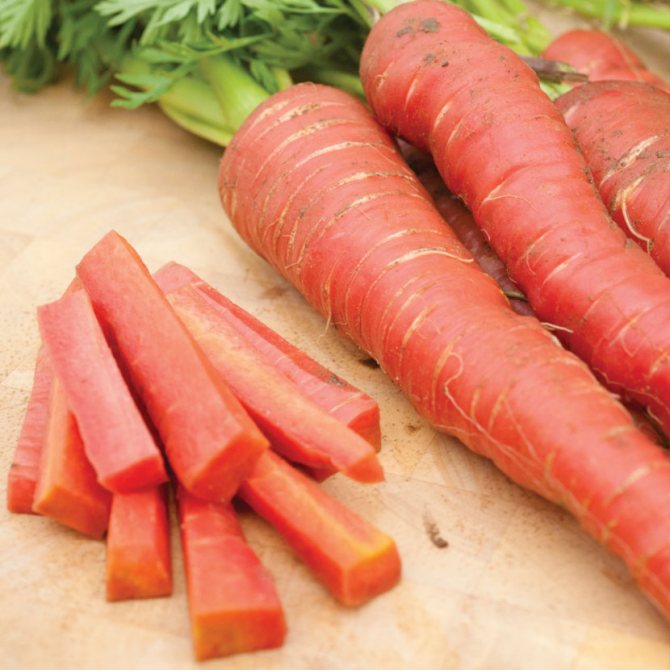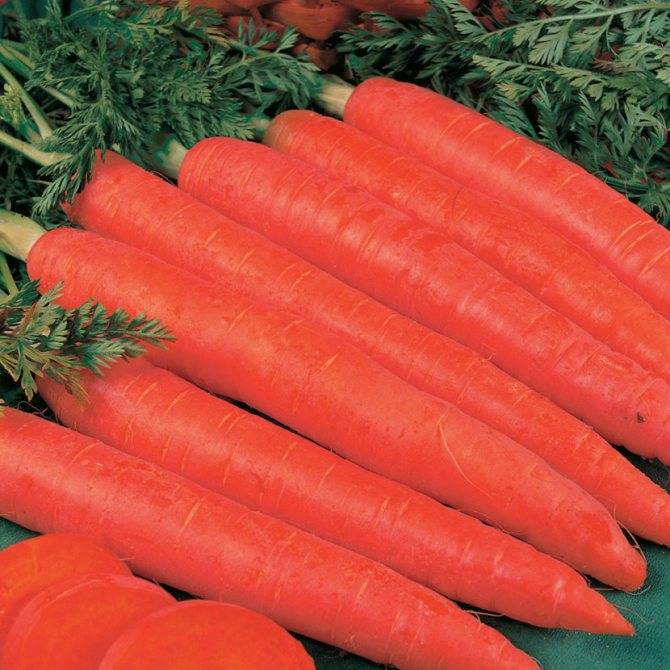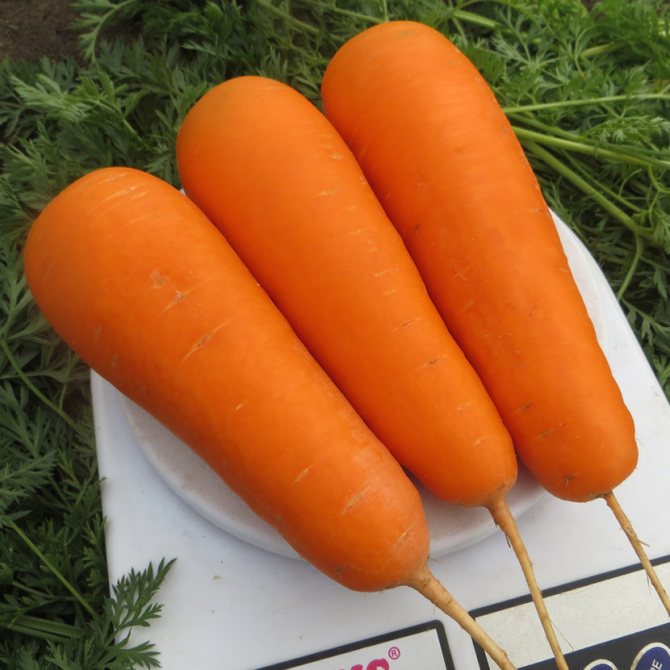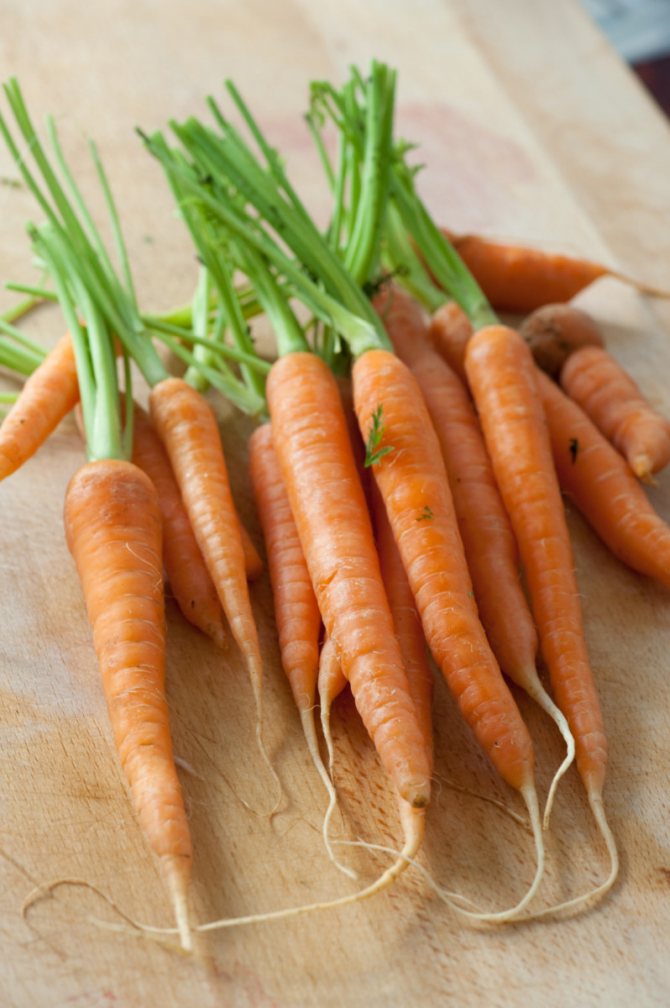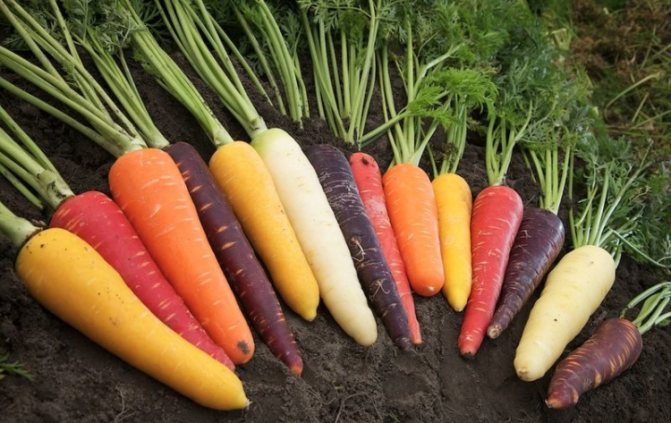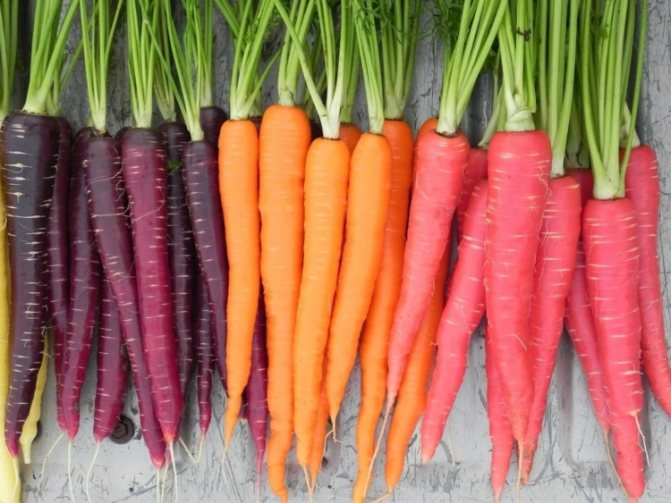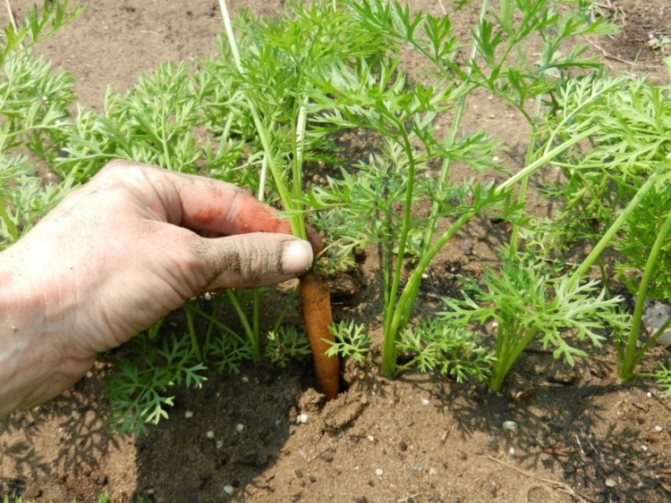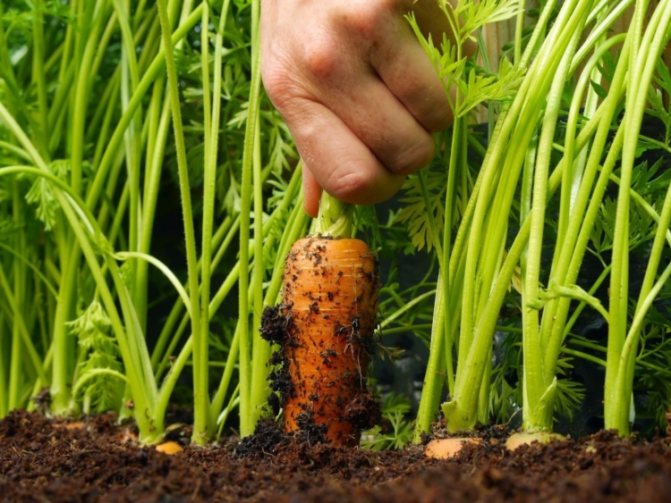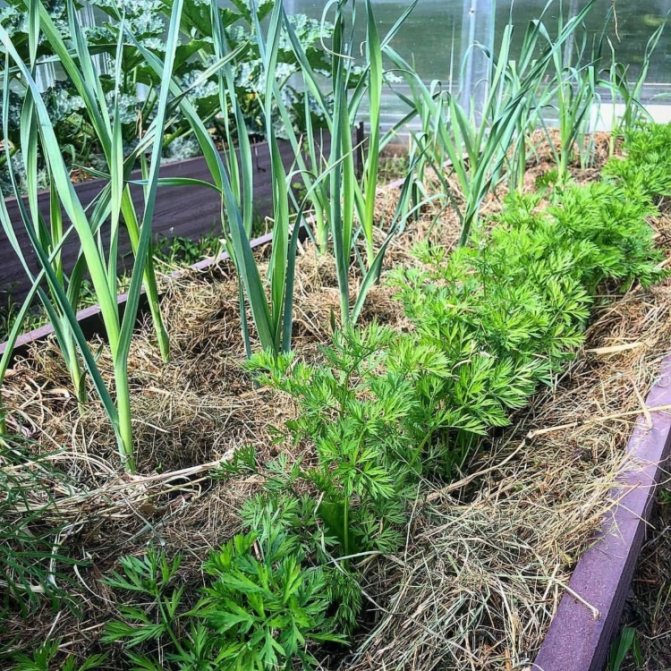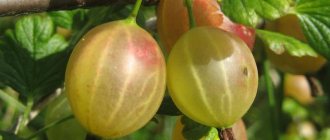The carrot is a biennial plant. Belongs to the Umbrella family and has pinnately dissected leaves.

It is still not known where it first appeared. However, Afghanistan is considered its homeland. It came to the European part only in the XX century. And her orange color was first bred in Holland in the 17th century.
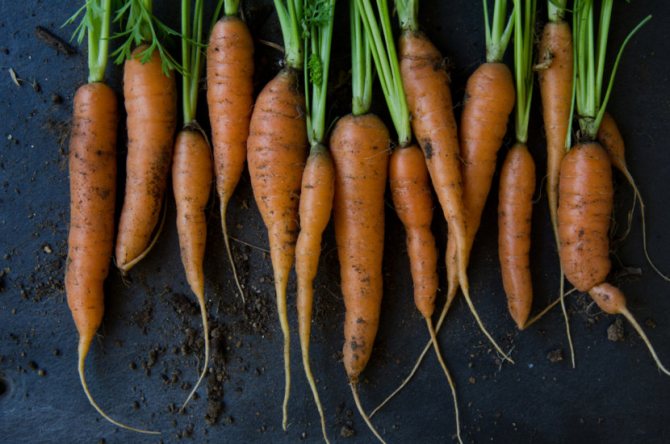

Today, there are more than 60 species of this root crop. In the photo of carrots, you can see how much they have significant differences among themselves, in weight, color, size.
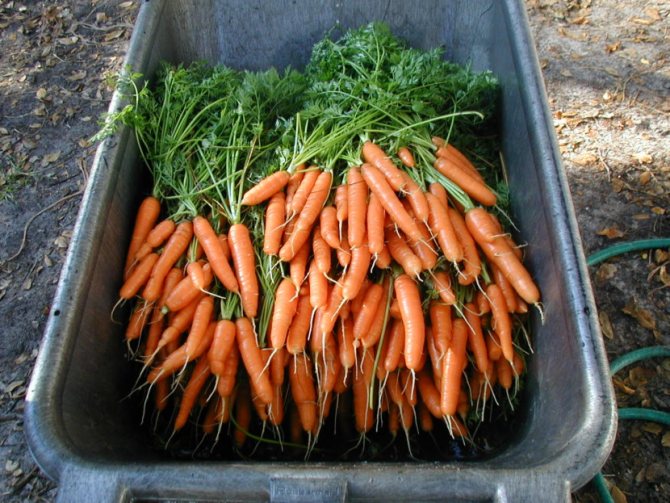

In ancient times, carrots were used only as a flavoring agent. The leaves and seeds of the fruit have a wonderful aroma. They began to add to food much later. After scientists found out that the root vegetable has beneficial properties.
A bit of history
Carrots are the oldest vegetable plant, used by people for more than 4 thousand years. The homeland of species with orange and reddish roots is the Mediterranean, and with white, yellow and purple - Afghanistan and India.
In ancient Greece and Rome, carrots were called "carote" and "daucus". The ancient Romans attributed this vegetable to the treats used for celebrations and holidays. He was also revered in the Middle Ages. Carrot dishes were treated to noble guests who had visited Karl the Famous in the 8th century. Only a little later, in the 16th century, this vegetable turned from a delicacy into an ubiquitous plant.
In the next century, fodder carrots were developed and are now massively grown in the UK. This variety is not very appetizing, but very large: its length can reach 40 cm, and its diameter is about 30 centimeters. Carrots came to our country in the 16th century.
Where do carrots grow?
Wild carrots can be found in many countries around the world. It grows both in European countries and in Asian countries. It is suitable for a mild and temperate climate.


It just does not grow in areas with severely arid climatic conditions or in the Far North. As a rule, carrots grow in the forest, along the roads or on the edges.
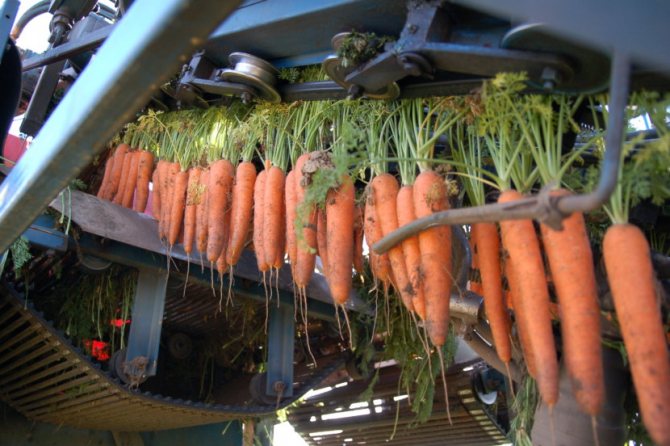

The composition and useful properties of the root crop
In terms of vitamin content, carrots surpass not only all vegetables, but also meat and dairy products. It contains many minerals - calcium, sodium, potassium, magnesium, phosphorus, iron, iodine and other essential minerals for humans.
The outer part of carrots contains the most nutrients.
Table 1. "Chemical composition of carrots"
| Structure | Nutritional value per 100 grams |
| Protein | 1.3 g |
| Carbohydrates | 6.9 g |
| Fats | 0.1 g |
| Water | 88 g |
| Alimentary fiber | 2.4 g |
| Ash | 1 g |
| Starch | 0.2 g |
| Organic acids | 0.3 g |
| Vitamins | |
| Beta carotene | 8.8 mg |
| Vitamin B3 / PP (niacin) | 1.1 mg |
| Vitamin C (ascorbic acid) | 5 mg |
| Vitamin E (tocopherol) | 0.04 mg |
| Vitamin B1 (thiamin) | 0.06 mg |
| Vitamin B2 (riboflavin) | 0.07 mg |
| Vitamin B5 (pantothenic acid) | 0.3 mg |
| Vitamin B6 (pyridoxine) | 0.1 mg |
| Vitamin B8 (inositol) | 29.2 mg |
| Vitamin B9 (folic acid) | 9 μg |
| Vitamin K (phylloquinone) | 13.3 mcg |
| Vitamin H (biotin) | 0.06 μg |
| Minerals | |
| Potassium | 200 mg |
| Calcium | 27 mg |
| Sodium | 21 mg |
| Magnesium | 38 mg |
| Phosphorus | 55 mg |
| Sulfur | 6 mg |
| Chlorine | 63 mg |
| Copper | 80 mcg |
| Zinc | 0,4 mg |
| Iron | 0.7 mg |
| Fluorine | 55 mcg |
| Copper | 80 mcg |
| Iodine | 5 mcg |
| Chromium | 3 μg |
| Manganese | 0.2 mg |
| Selenium | 0.1 mg |
| Vanadium | 99 mcg |
| Molybdenum | 20 mcg |
| Boron | 200 mcg |
| Nickel | 6 μg |
| Aluminum | 326 mcg |
| Lithium | 6 μg |
| Cobalt | 2 μg |
Carrots are a low-calorie product: 100 grams contains 35 kcal. A boiled root vegetable contains 7 to 10 fewer calories.


Carrots can be eaten at any time of the year, as they are perfectly processed and preserved. It can be pickled, fermented, dried, frozen, and salted. Not only root crops, but also young tops are edible in a vegetable.
Carrots contain a lot of carotene - a substance that is converted into retinol (vitamin A) in the human body. So in 100 grams of raw carrots contains 9 mg of carotene. For reference: this is 8 times more than tomatoes. Retinol is extremely important for the proper physical and mental development of children, as well as contributes to skin elasticity and improved metabolism. With its deficiency, the skin becomes dry, pustules may appear on them, and the nails become brittle. This is why retinol is known as a beauty vitamin. For better absorption of carotene, carrots need to be grated and seasoned with oil (vegetable, butter) or sour cream. A typical manifestation of vitamin A deficiency is night blindness, in which visual impairment occurs at night and at dusk.
Carrots have a choleretic, anthelmintic, antiseptic, anti-inflammatory, analgesic, anti-sclerotic and expectorant effect on the body. It also enhances the work of the digestive system.
Carrot juice helps to relieve fatigue, increases the body's resistance to colds, improves appetite, eyesight and complexion, reduces the toxic effects of antibiotics on the body.
Carrots during pregnancy
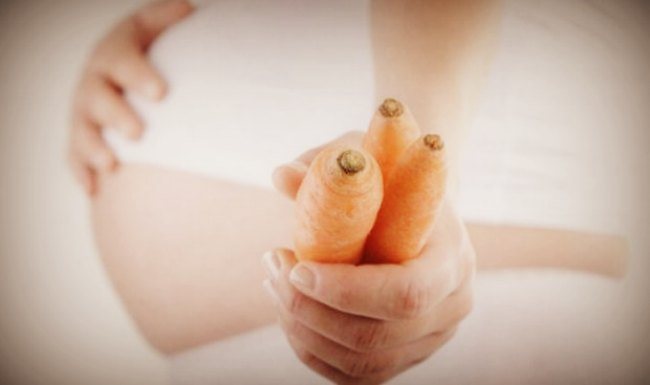

First trimester
Due to the increased production of progesterone, a decrease in immunity occurs. This increases the likelihood of contracting infectious diseases that pose a real threat to the health of the expectant mother. Therefore, she needs to eat at least 2 pieces daily. carrots, which will have a tonic effect on the body and help to strengthen the immune system. Folic acid, contained in it, promotes the formation of the placenta, and iron will prevent the development of anemia.
Second trimester
The potassium contained in carrots will support the heart, which takes on a double load during this period. Phosphorus is necessary for the formation of the skeleton of the unborn child, and a large amount of vitamins will help eliminate bleeding gums. In addition, carrots are endowed with a weak diuretic effect, therefore, they will help get rid of edema.
Third trimester
Just 2-3 carrots, eaten per day, will help get rid of heartburn and prevent the appearance of stretch marks. Because even this amount of vegetables is enough to provide the body with vitamins A and E, which are involved in the synthesis of collagen and elastane.
The presence of vitamin K in the composition improves blood clotting, therefore, blood loss during childbirth will be less. And vitamin B3 is "responsible" for the development of the baby's nervous system. Fiber can help improve bowel function and relieve constipation.
The benefits of boiled carrots
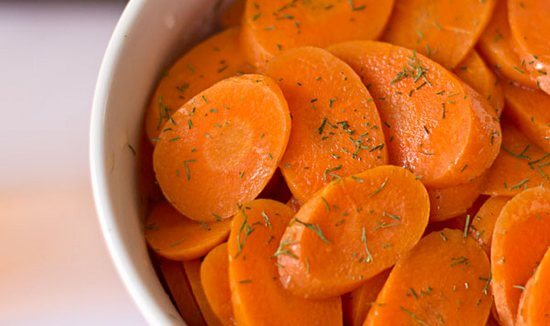

Scientific studies have shown that boiled carrots have more antioxidant properties than raw carrots. When cooked, antioxidant levels increase by almost 34%. Antioxidants not only rejuvenate tissue cells and skin, but also prevent the development of many diseases of the brain and nervous system, in particular Alzheimer's disease.
Boiled root vegetable helps to treat dysbiosis, nephritis and malignant neoplasms. It has antimicrobial properties. For medicinal purposes, nutritionists advise using a young vegetable of bright red color.
Boiled carrots are often included in the diet of people suffering from diabetes, because they tend to normalize blood sugar levels, while saturating the body well.
To whom the product is recommended
Carrots are considered an important product on the menu of any person. Its roots are especially useful for:
- Diabetics.
- Children.
- Pregnant and lactating women.
- Elderly people.
The latter do not need to be afraid to consume the product, because it belongs to vegetables with low allergic properties, and its regular inclusion in the diet minimizes the risk of developing sepsis after childbirth.
The vegetable is perfect as a prophylactic agent for various diseases. Carrot juice is advised to drink when overexcited and people with an unstable psyche, as well as those who have high blood cholesterol. Scientists from France have even discovered its beneficial effect on pulmonary tuberculosis.
It is also advised to eat a vegetable for people suffering from the following pathologies:
- diabetes;
- anemia;
- angina;
- constipation and indigestion;
- bronchitis;
- avitaminosis;
- obesity;
- poisoning;
- myocardial infarction;
- hemorrhoids;
- impotence;
- hypertension;
- eczema.
Vitamin A is important for the health of a woman's ovaries. Therefore, it is advised to include carrots in your diet for infertility and diseases of the genital organs. The tops of the vegetable should be eaten by people with high blood pressure. Fresh carrot juice is used to treat thrush in children by lubricating the oral cavity with it.
The benefits of foliage
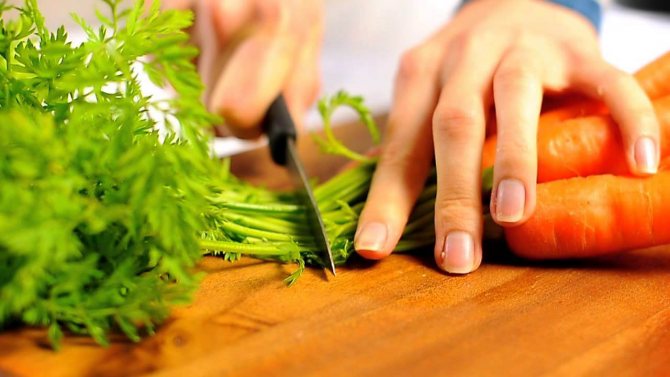

Many useful substances for the human body are contained in carrot tops. From greens with root vegetables, you can prepare a filling for tortillas or pies. Also, when boiled, pleasant decoctions come out of it, making it possible to make the taste of soups more intense.
The leaves and stems of the tops help reduce the appearance of varicose veins. To do this, you need to prepare a decoction - pour 2 tablespoons of tops in a chopped state with 2 cups of boiling water, insist overnight. Drink half a glass 2-3 times a day. To get rid of hemorrhoids, the tops should be brewed like tea. The drink can be consumed without restrictions throughout the day. The duration of treatment is 1 month. By applying carrot tops to the back of your head, you can get rid of various sleep disorders. With prostatitis, you need to make compresses on the lower abdomen from mashed carrot tops every day. With cystitis, pour a handful of chopped tops with 500 ml of boiling water and leave for an hour. Drink 30 minutes before meals 3 times a day.
Reviews and opinions of doctors
Judging by numerous reviews, carrot tops are actively used for the treatment and prevention of many diseases. These include hemorrhoids and thrombosis. Tops are considered one of the safest and cheapest remedies in the fight against these diseases. Many women have tried dried carrot tea to get rid of varicose veins and were pleasantly surprised that the vein mesh disappeared.
Often, juice is prescribed to patients who have suffered a heart attack. Doctors warn that you should not get carried away with this drink. The amount of carrot juice should not exceed 2 glasses a day.
Conclusions:
Having studied the useful and harmful properties of carrots, the following conclusions can be drawn:
- Heat treatment has little effect on the unique composition of the product.
- Carrots have a beneficial effect not only on the condition of the eyes, but also on all human organs.
- You should carefully consider contraindications before including carrots and their juice in your diet. Do not exceed the recommended dose of the product.
- Those who regularly use the vegetable as food talk about its healing properties, which helped to get rid of serious pathologies.
Carrots are one of the most popular products in the preparation of various dishes, as well as a valuable tool that is actively used in folk medicine. If you make this vegetable a frequent guest on the table, you can forget about many health problems.
Rate the material:
Ratings: 9 (4,78 out of 5)
Admin
27.01.2017
17017
1
Found a bug? Highlight it and press Ctrl + Enter
Report a bug
Similar posts


Seaweed (kelp): benefits and harms, application
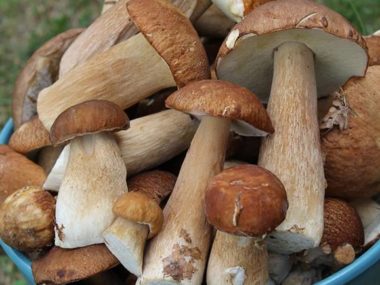

White mushroom: description, application, recipes, photos
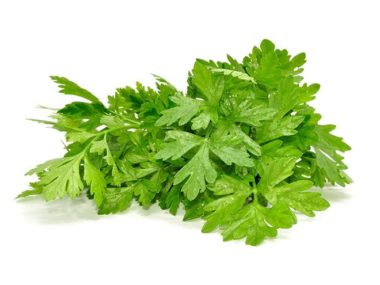

The benefits of carrot juice


Carrot juice helps relieve fatigue, increases the body's resistance to colds, improves appetite, eyesight and complexion, and eliminates constipation.
It has the ability to strengthen the retina of the eyes, so doctors advise people who have vision problems to drink carrot juice every day. If a person has to work at a computer for a long time, then it is worth regularly drinking it on an empty stomach.
Carrot juice with honey can help relieve hoarseness and coughs. It is also useful for diseases of the kidneys and liver, as well as cardiovascular pathology. Carrot juice is advised to be consumed by the elderly and pregnant women. It also allows you to eliminate spring vitamin deficiency - for this purpose, juice is consumed three times a day, half a glass.
Growing features
How to plant correctly?
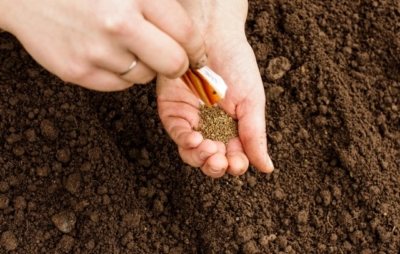

Highlights:
- Treat the seeds before planting.
- Location: plot with good natural light. The site is prepared in the fall, fertilizing it with humus and fertilizers. And then they dig it up.
- In the spring, before planting, the soil is loosened and leveled.
The soil temperature for planting should be 4-6ºC.
Disembarkation dates:
- early ripe carrots - mid-April;
- middle and late - from the second half of April to the second week of May.
In the open field
How to plant:
- Process the seeds.
- Grooves are made with a depth of 2-3 centimeters.
- Moisten the grooves.
- Place the seeds at intervals of 3-4 centimeters.
- Cover the grooves with soil and mulch the soil with peat or straw.
We talked more about the nuances of planting carrots in open ground here, and read about the secrets of growing in different regions in a separate article.
Selection and storage rules
When choosing carrots, you need to consider the following points:
- Pay attention to the shape of the vegetable. It should be firm, with a smooth surface, no cracks or build-ups, and a regular shape. It is better to choose carrots with green tops - this indicates their freshness.
- Choose medium-sized carrots - they are easier to cook. Large carrots are very often tough.
- A young thin vegetable is sweeter.
- No need to take carrots with sluggish tops, cracks or spots, soft and with a green zone at the base.
What is the best way to store carrots? It is important to do this:
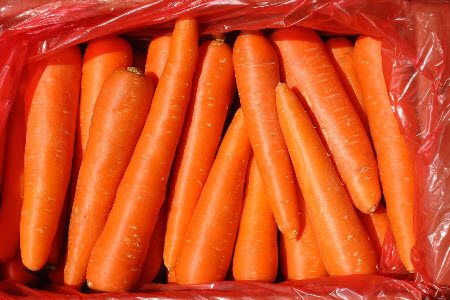

Remove the tops, as it will absorb nutrients and moisture from the root crop.- Then the carrots should be wrapped in bubble wrap - this way you can keep the moisture in the optimal amount and freshness for several weeks. When stored in plastic bags, the decay process occurs quickly.
- Store wrapped carrots in the refrigerator. It is best to use it for 1-2 weeks - it is at this time that it has the best taste and nutrient content.
- You can store the vegetable in the basement in small boxes with a lid and dense walls. For longer storage, you need to take coniferous sawdust. They contain essential oils that prevent rot and sprouting. Also in the cellar, carrots can be stored by placing them in the sand.
- When growing your carrots, you can leave a small amount in the ground. A small snow cover will protect it from freezing, and with the arrival of spring it will be possible to harvest.
The shelf life of the root crop depends precisely on the storage option:
- in a film in the refrigerator - 1-2 months;
- in the sand - 6-8 months;
- in closed boxes - 5-8 months;
- in coniferous sawdust - about 1 year.
The best early ripening carrot varieties
Amsterdam
For technical maturation, 80 to 85 days are enough. With proper care and proper weather, you can gain up to six kg. Medium-sized, deep orange, in the form of a cylinder with a blunt end and a narrow core of the same color. In length it can reach 16 centimeters. The maximum weight that grew up was 70 grams. Carrots of this variety are juicy and sweet. Moisture-loving. Even with excessive watering, it does not burst.Demanding on the soil, which should be light, fertile, with a deep plowed layer.


Lenochka
In terms of the characteristics and characteristics of cultivation, this type of carrot is similar to the Amsterdam carrot. Except for the length: usually not exceeding 14 centimeters and the "jumping" weight of the vegetable, when 130 grams will be, and when only 80. As well as medium-term storage time. The harvest is not very good, maximum 4.5 kg.


Beloved
A variety of carrots, weighing 150 grams, characterized by a high percentage of carotene. Poured honey pulp. Excellent yield, with high moisture tolerance. Good in long-term storage. Fruits up to 14 cm long practically do not stick out of the soil. In cooking, it is recommended to use for processing.


Orange nutmeg
A proven, consistently productive variety of carrots - 5.3-5.9 kg. Lezhky. In the root vegetable, the core is almost absent. It grows up to sixteen centimeters, weight - from 120 to 145 grams. Excellent taste. Sowing vegetable seeds is carried out in April-May to a depth of one centimeter. The distance between the rows is desirable at 20 cm. When thinning, leave about five cm between shoots.


Fairy
These carrots are suitable for a long saving period. Ripeness occurs after 100 - 110 days. The grown roots are in the shape of a cylinder with a pointed end. The color is red. Weight from 85 to 175 gr. On average, no more than 4 kg comes out from the "square". Taste quality at the level.


Minicore F1
A hybrid carrot variety with a high yield of 7-8 kg. Matures within 75-90 days. Cylindrical, orange. The length of vegetables does not exceed 15 cm, in diameter - 1.5. They weigh on average about 90 grams. It guarantees early carrots for personal consumption, but is also good for marketing. Recommended for children. The shelf life is limited.


Cooking use


Carrots can be used to make a variety of dishes It goes well with almost any food: cereals, other vegetables, meat. It is a part of second courses, soups, salads, sweet products. It is eaten stewed, canned, boiled, raw and dried.
Carrots have a sweetish taste, which depends on the variety: there are roots of varying degrees of sweetness. The peculiar aroma of the vegetable is determined by the essential oils that are present in its composition.
When cooking carrots, you must follow some rules:
- Cook dishes with sour cream or butter. This is because the carotene contained in the vegetable is fat-soluble, and it is such a preparation that will contribute to the better absorption of vitamin A.
- To preserve the nutrients, it is better to stew and steam carrots.
- It is imperative to cook the vegetable under the lid - this way you can preserve all its useful composition, aroma and taste.
- For fans of a raw food diet, it is better not to grind carrots, but to gnaw them. This is because when its surface touches the metal, some useful substances volatilize. Plus, chewing this vegetable raw can strengthen your teeth.
What exactly can be prepared from carrots?
- Juice - has a wonderful taste and contains many useful substances. In order to get the necessary vitamins, it can be combined with other juices.
- Carrot Puree - Can be added to a variety of dishes, including rolls and sauces. This is a healthy dish for children.
- Julienne from carrots.
- Carrot halva - it is very tasty and low in calories, therefore it is used as a snack between main meals or as a dessert.
- Carrot cake - in addition to its excellent taste, it has maximum benefits, its regular use has a positive effect on vision.
- A carrot, pepper and salt snack is a great healthy meal option.
Carrots are used in dietary nutrition for anemia, hypovitaminosis, liver, kidney and cardiovascular diseases.
Types of root vegetables
There are only two types of carrots:


Wild. It grows naturally. Has a white or slightly yellowish tint. This fruit is not used for food.


Sowing.Human grown. It is a subspecies of wild carrot. This type is subdivided into two varieties of carrots:


- stern;
- dining room.
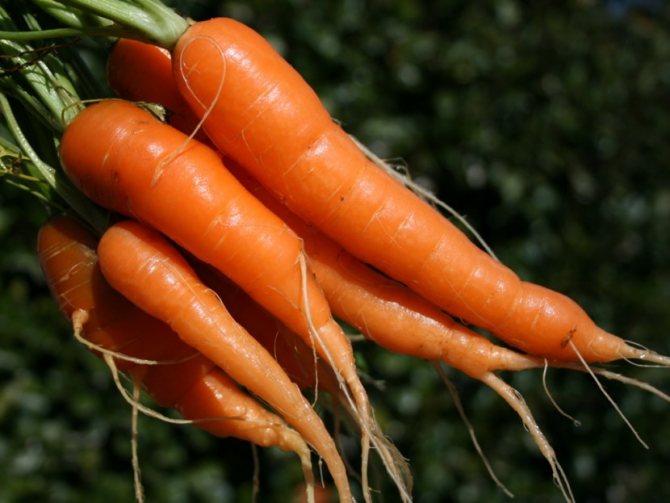

Table carrots / These varieties are grown for food consumption. The ripening period can be different:


- early;
- mid-season;
- late.


The early ones can be eaten raw or cooked. Mid-season is best eaten cooked. The late variety is the sweetest, it grows for more than 200 days.
Use in cosmetology


It is widely used in cosmetology. Carrot juice relieves inflammation, dries a little and disinfects the skin. Only whole freshly squeezed carrot juice can be used, never from packets.
Face care
In the presence of skin rashes (acne, acne, etc.), as well as freckles, the cleansed skin should be wiped with a mixture of carrot and lemon juices.
You can make carrot face masks. In order to remove dead cells, you must first use a scrub. This prevents the skin from turning orange. Before use, it is imperative to conduct a test - first apply the mask to your wrist to make sure there is no allergy to carrots. For masks, you can use the vegetable both raw and boiled. You need to keep masks with carrots for no more than 15-20 minutes, do it once a week. Let's dwell on some of them.
For dry skin
Grate the carrots on a fine grater, take 2 tablespoons of it, add a teaspoon of olive oil and 1 yolk. Stir everything. Apply the mask to the face, then rinse with warm water.
For combination skin
We connect 2 tbsp. tablespoons of boiled carrots, finely chopped with 1 teaspoon of honey. Apply on face and rinse off after 15 minutes. This mask is used when there is no allergy to honey. It perfectly moisturizes, nourishes the skin, makes it beautiful and radiant.
For oily skin
We take 2 tablespoons of raw grated carrots, 1 teaspoon of flour and 1 egg white, mix everything and apply the mask to cleansed skin for 20 minutes. After 20 minutes, wash off. This mask allows you to narrow pores, dries the skin and increases its elasticity, removes oily shine from the face.
In addition to masks, you can make cosmetic carrot ice. To do this, the vegetable juice must be poured into molds and frozen. Then they rub the face with such a cube of people in order to moisturize and give freshness. Then they wash themselves with water.
Hair care


Carrots will also help strengthen your hair and give it a beautiful shine. To do this, after washing, they need to be rinsed with a decoction of carrot tops. Then wrap up the hair and hold it for an hour. You do not need to wash off. Hair can be rinsed with carrot juice diluted in half with water. You can also dilute with infusions of some plants - calendula, chamomile, string.
You can prepare special hair masks that include carrots:
- When planning to wash your hair, rub grated carrots, previously mixed with burdock oil (2 tablespoons), into your hair. Let sit for 10-15 minutes and wash off with cool running water. Then wash your head with shampoo.
- Stir the grated carrots with 1 tablespoon of honey, rub into your hair. After 10-15 minutes, rinse off the mask and wash your hair with shampoo.
- Mix 1/4 cup of carrot broth with the same volume of strong chamomile infusion. Add 1 chicken egg yolk and 1 tablespoon of castor oil. Apply to hair and rinse after 10-15 minutes.
- Take in equal parts (1/4 cup) carrot juice and strong nettle infusion, mix and dilute 1 teaspoon of sea salt in the resulting liquid. Dampen hair in the resulting solution and hold for 5-10 minutes. Rinse off first with running water and then, as usual, with shampoo.
- Grind dried chamomile flowers in a coffee grinder, fill them with infusion of carrot tops (a small amount) so as to get a non-liquid gruel.Add 1 egg to the resulting mass, stir and apply to hair, hold for 15-20 minutes, then rinse.
Hand care
A decoction of carrots will make the skin of your hands soft and velvety. Therefore, it is used to prepare baths:
- Dissolve 1/2 teaspoon of baking soda and 1 tbsp in warm broth. l. honey. Lower your arms for 10-15 minutes.
- Take equal parts of the broth of carrots and milk, stir and soak for 10-15 minutes.
- Dissolve baby soap (a small piece) in hot carrot broth, cool everything a little and hold your hands in this mixture for 10-15 minutes.
It is not recommended to do too hot baths - this is the only way to dry out the skin. After the procedure, rinse your hands with warm water, wipe dry and lubricate with cream.
Carrots have a wound healing effect. Therefore, if there are cracks in the hands, carrot gruel can be applied to the affected areas, which will help get rid of this problem.
Before performing a manicure, you need to prepare your hands. To do this, you can use a decoction or juice of carrots, which help to strengthen the nails and soften the skin of the hands.
Feet care
Carrot broth is also used for foot care. It will help in such cases:
- With hardened skin on the legs, take 3 liters of carrot broth, dissolve mustard in it - 3 tbsp. spoons. Use this mixture for a bath, after which rub the coarse areas with a pumice stone, rinse your feet with cool water, wipe dry and lubricate with cream.
- A bath of 3 liters of carrot broth and 2 tablespoons of baking soda will soften the skin of the feet.
- To relieve fatigue, make a foot bath of carrot broth with chamomile or sage infusion.
Diseases
- Rhizoctonia - fungal disease. Carrot leaves turn yellow and dry out. To prevent, you should not plant carrots in places where the soil is waterlogged.
- Carrot fly... The tops of the plant become bronze. If the plant is not treated in time, the foliage may wither and the plant may die. It should be treated with special means: "Tsiper", "Arrivo", "Sharpei".
- Carrot lily... Appearance period: March. The hatched larvae cause the tops to shrink and dry out. Spraying with tobacco broth should be done.
- Aphids on carrots... Transfers from old plants. To fight, you should:
- abundant watering in the heat;
- sprinkle with ash;
- spray with herbal infusions.
Read more about the symptoms and causes of carrot diseases, as well as the methods of their treatment, in a separate article.
Slimming
The carrot diet is very often used for weight loss. It is not only very healthy, but also delicious. This diet can be used in different ways depending on the goal (for 3, 7 and 10 days).
For 3 days
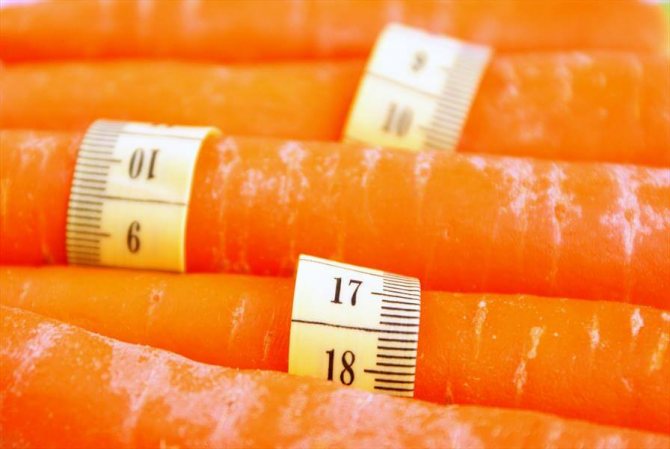

During the course of such a diet, you can lose 2-3 kilograms. All this time, the root crop can be eaten without any restrictions, in any quantity.
The rules for the three-day carrot diet are as follows:
- nothing can be eaten except carrots;
- you can use lemon juice for salad;
- the root crop should be fresh, chopped on a fine or medium grater;
- be sure to drink several glasses of freshly made juice per day; non-carbonated water and green tea without added sugar are also allowed from liquids.
Rules 3 and 4 can be applied to the seven- and ten-day diet as well.
The food scheme for such a diet is 6 times a day.
For 7 days
A weekly course of the carrot diet will allow you to get rid of 4-6 kilograms. The power scheme in this case is as follows:
- Breakfast: carrot salad, seasoned with 1 tsp. honey, a glass of low-fat kefir.
- Lunch: carrot salad with kiwi, seasoned with sour cream - 1 tbsp. spoon.
- Afternoon snack: salad of boiled carrots with apple, seasoned with sour cream.
- Dinner: carrots with fruits (any), low-fat cottage cheese - 120 g.
Menu items are repeated daily.
For 10 days
When planning to get rid of 7-9 kilograms, you can apply a ten-day carrot diet. It is very tough, so the menu is poor. Throughout the entire time, you can only eat carrots seasoned with 1 tbsp.a spoonful of low-fat sour cream. At this time, you will feel severe fatigue, because the body's protein reserves are consumed, not replenishing. This will be especially pronounced during physical exertion. But after 4 days you can see the first result.
To diversify the menu, salad can be made from boiled root vegetables, but you should not do this more often than once a day. You can drink 2-3 glasses of carrot juice per day.
Contraindications
You cannot resort to such a diet if you have problems with the cardiovascular system and digestive organs, since any mono-diet is a high load on the body. It is not advisable to go on a diet for lactating and pregnant women. In the presence of chronic pathology, the diet can be used only after consultation with a specialist or under medical supervision.
Important! Do not drink carrot juice on an empty stomach. It is better to drink a glass of water an hour before breakfast.
Long-term use of carrots in people with fair skin may develop an icteric shade. Therefore, they do not want a diet that lasts more than 3 days.
As soon as the state of health worsens, you need to interrupt the diet.
Diet exit rules
To consolidate the achieved result, you need to get out of the carrot diet correctly.
On the 4th, 8th or 11th day, depending on the duration of the course, you can introduce into the diet a little baked or boiled potatoes and a slice of rye bread. Then dairy products with low calorie content are gradually added, then vegetables and meat.
Even after achieving the desired result, do not rush to return to buns, sweets and other delicacies. After all, gaining weight again can be faster than losing it. Don't forget this!
Recipes
Carrots, like all vegetables, belong to the category of alkaline products, and to preserve all the useful properties, they must be steamed. If you want to pamper yourself with something spicy, dietary or unusual, then you should pay attention to the recipes below.
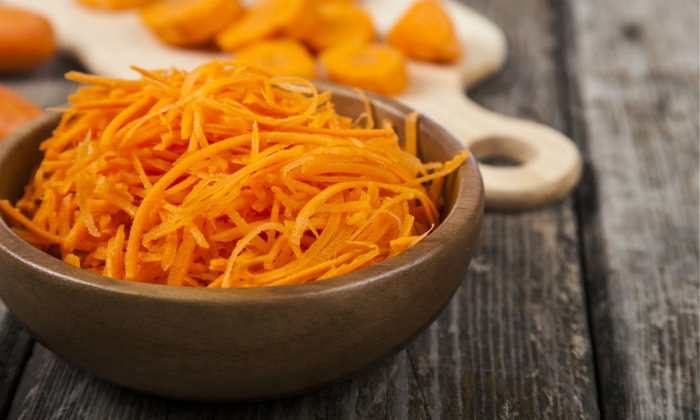

Korean carrots
Based on 1 kg of carrots, you will need:
- Vegetable oil (linseed oil can be used) - 100 g.
- Garlic - 5 cloves.
- Red hot and mild peppers - 0.5 tsp each.
- Ground coriander - 2 tsp
- Soy sauce to taste
- 4 tbsp. l. 9% vinegar.
Grate large carrots on a special grater, put all the other ingredients (chop the garlic using a press), mix everything, pour over with vinegar and oil, and the latter can be preheated a little.
When cooking carrots in Korean, it is necessary to use a special grater, because the taste and aesthetic characteristics of the dish depend on it.
Beetroot and carrot salad
There is a salad called "Brush" or "Broom", and it consists of apples, cabbage, carrots and beets, taken in equal proportions. It can be filled with oil or not. This dish is intended for everyone who wants to lose weight. For gourmets, there is another recipe:
- Beets and carrots - 400 g each.
- Green onions are a small bunch.
- Cashew nuts - 50 g.
- Yogurt "white" - 200 g.
- Honey - 1 tsp
- Pepper and ground ginger root to taste.
Grate vegetables on a coarse grater, finely chop the onion, chop the nuts. Mix all the ingredients and dress the salad with a sauce of honey, yoghurt and spices.


Carrot tea
For the preparation of a healing drink, dried, fresh carrots or their tops can be used. To prepare for future use "tea leaves", you need to dry the grated carrots in the oven or dryer for vegetables. It should be stored in a cloth bag. To make tea, you need to take dry raw materials per each glass of boiling water. The brewing time is 20 minutes. This tea is best drunk with honey.
Harm and contraindications
Despite the benefits, carrots can be harmful in some cases. We are talking about allergic reactions and overeating.
If you eat more than a kilogram of this vegetable per day, you may experience an upset stomach with unpleasant consequences.It is also possible to develop carotene jaundice - the whole body and face will be covered with characteristic yellow spots. If this happens, then carrot lovers need to refrain from using it for several days and the spots will gradually disappear.
There are a number of contraindications for eating carrots. You can not eat it with inflammation of the small intestine, peptic ulcer of the duodenum and stomach. Do not get too carried away with the juice of this vegetable, because the excess amount of carotene in the body has a negative effect on the liver. In turn, the liver cannot cope with the absorption of this substance, which can lead to carotene hepatitis.
More fresh and relevant health information on our Telegram channel. Subscribe: https://t.me/
Carrot seed preparations
There are medicines that are made on the basis of carrot seeds. These include:
Urolesan
The product contains wild carrot seeds. It is prescribed for urolithiasis and inflammation of the urinary tract. The drug is available in capsule form. It is contraindicated for children, pregnant and lactating women, as well as for persons suffering from gastritis, gastric ulcer and 12 duodenal ulcer.
Daucarin
The drug is prescribed for coronary insufficiency and atherosclerosis. It is also prepared from carrot seeds. The tablets are a natural preparation, so they have no serious contraindications.
Plant allergy - symptoms, treatment
Carrots are a common in the diet, valuable in terms of their vitamin composition, but, unfortunately, some people may have an allergic reaction to it. It manifests itself in the form of the following symptoms:
- vomiting, nausea, stool problems, pain;
- lowering blood pressure, dizziness;
- rhinitis, nasal congestion, sneezing;
- conjunctivitis;
- itchy skin, rash;
- Quincke's edema.
Most often, all the same, the manifestation of an allergy to carrots is accompanied by local reactions that pass quickly enough. People who are allergic to pollen are sensitive to carrots:
- birch;
- wormwood;
- ragweed;
- dandelions.
This is a cross-reaction. There may be an allergy to substances in the carrot itself, then the vegetable and contacts with it are completely excluded. In case of severe reactions, it is necessary to consult a doctor for prescribing treatment.
Characteristics and description of carrots, photo
What is it - vegetable, fruit, root vegetable or grass?
According to the botanical classification, carrots are a vegetable crop. Vegetables include plants that provide human food with roots, tubers, leaf crops, bulbs and some others. Due to trade rules, the European Union classified carrots as fruits in a special document in 1991, which does not correspond to the scientific classification.
What does it look like?
Carrots are a herbaceous plant that consists of an aerial part - leaves and an underground part - a root crop. Leaves, depending on the variety, in various shades of green, pinnately dissected. The root vegetable is fleshy, the shape depends on the type of carrot, it can be:
- conical;
- elongated conical;
- cylindrical;
- fusiform.
Root color:
- orange of different saturation;
- red;
- yellow;
- less often purple, white.
Root weight up to 500 g.
Botanical description - what family and genus does it belong to?
Cultivated carrots belong to the species wild carrots, the family of umbrella or celery plants, the dicotyledonous class. Cultivated carrots are divided into table and feed varieties. Table varieties are the most delicious, have a high content:
- vitamins;
- sugars;
- carotene.
Fodder varieties are used to feed farm animals.
Structure
Carrots are a biennial plant, in the first year of growth forms a rosette of leaves, stem, root system. In the second year, when planting a root crop, a seed bush is formed. Carrot flowers are bisexual, forming an inflorescence in the form of a complex umbrella. The fruit is a small two-seed, with a high content of essential oils.
Biological features
Carrots are cold-resistant plants. Seeds begin to germinate at about 5 degrees Celsius. It belongs to long-day plants, forms a good yield of root crops with sufficient light. It is moisture-loving, in the period from sowing to germination it requires a large amount of moisture, drying out of the soil at this time kills carrot sprouts.
Carrots give excellent yields on light loam and sandy loam... On heavy and waterlogged soils, small, gnarled root crops often grow.
How and where does it grow?
In nature
Wild carrots grow in all mild to temperate regions, avoiding deserts and northern conditions. It can be found in:
- Mediterranean;
- Europe;
- Africa;
- countries of Asia.
At home
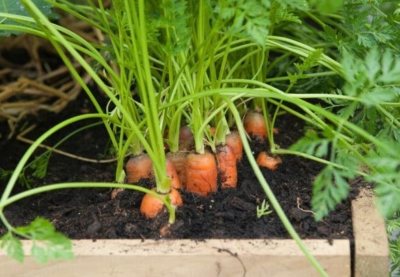

Carrots can be grown in an apartment. Early varieties with a short root crop are chosen for the garden on the windowsill. You can sow at the beginning of March, when there is already a sufficient amount of sunlight. The container for growing "home" carrots must be opaque, at least 15 cm deep, with holes for water drainage.
Drainage is required. It is better to buy the soil in the store. The seeds are planted in a container at a distance of 4 cm from each other, the depth is 1.5 cm. If the crops are thickened, the carrot shoots are thinned out. In a small container, 1-2 plants are grown. Care consists in regular watering, feeding. Recommended varieties for a home garden:
- Caracas;
- Marlinka;
- Granddaughter;
- Rondo;
- Polar cranberry;
- Alenka;
- Karotel.
In the garden
If we talk about sowing carrots, then it grows in every vegetable garden, is part of the "obligatory" vegetable crops for planting in the open field.
How and when does it bloom?
Carrots bloom in the second year of life. If you plant a carrot root crop in the ground in the spring, you can get a flowering bush, and then seeds. Carrot flowers are small, up to 2-3 mm, can be white, reddish, cream, five petals per flower. Flowers are collected in inflorescences, the inflorescences form an umbrella. The seeds are ready for harvest in August. The flowering of carrots in the first year of life is due to a violation of agricultural technology, a flowering plant will not give a root crop.
Further in the photo you can see what a fresh carrot looks like and how it grows in the garden:
Why can the curve grow?


Main reasons:
- stony or clay soil;
- an excess of organic fertilizer;
- drought and lack of watering;
- thickening of seedlings and lack of weeding;
- root damage due to untimely weeding;
- an excess of calcium in the soil due to the introduction of lime;
- excess chlorine;
- damage by pests;
- late harvest.
You can find out more about the causes of defective carrots here.
Sowing and sprouting
You can use the "grandmother's" method and just germinate the seeds in a damp gauze and a saucer until persistent five-millimeter roots appear.


Recommendations for germinating carrot seeds
The prepared seeds are sown densely in the grooves prepared on the garden bed, covered with light soil. From above, the soil is compacted with a board or hands.
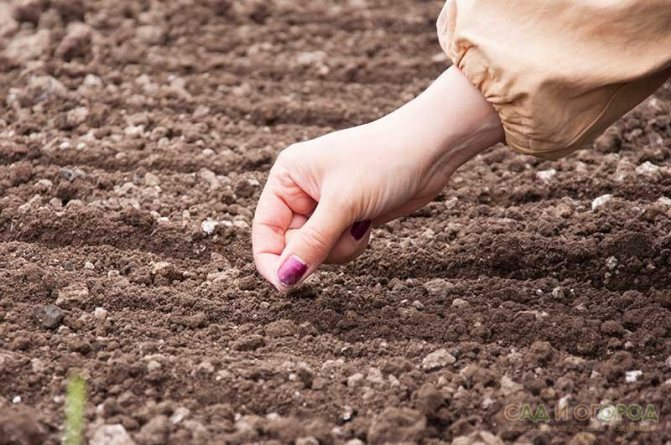

In the photo, the process of sowing carrots
The optimum temperature for carrot seedlings is + 15… + 18 ° C. Prepared seeds germinate within 10-12 days.
How to give carrots to children?


Carrots are one of the first foods for baby food... It is introduced into feeding very carefully, starting with small trial doses. It is recommended to give boiled carrots not earlier than 7 months, raw grated carrots - not earlier than 10 months. After adding carrots to complementary foods, it is imperative to monitor the reactions of the body. Symptoms of allergic reactions in a child are the same as in adults. For any allergies, show your baby to a doctor.
Season
To select planting material, gardeners rely on basic requirements. The future harvest depends on them: its quantity and quality. For regions with low night temperatures, varieties of the mid-season and late-season type are suitable.For the southern regions of the country, early maturing varieties are chosen.
Ripening terms:
| Early | Up to 90 days |
| Average | From 90 days |
| Late | From 110 days |
Gardeners with experience recommend planting 1-2 types of varieties per season. Thus, the harvest will begin to ripen gradually, part of it will be in demand during processing, the other part will go to storage.
How to choose white carrots
You should not buy root vegetables if:
- they are soft to the touch - the carrots have been stored for too long and have largely lost their valuable qualities;
- the remains of the tops are dark, dry, stale - this means that these are too old vegetables;
- fruits have many branches - such a symptom indicates obvious violations of agricultural technology.


Preparing the garden for planting carrots
Pre-sowing preparation of the soil makes it suitable for planting, increases the resistance to the formation of a pathogenic environment and the survival rate of the root crop. Events are held in several stages:
- In the fall, the landing area is dug onto a shovel bayonet 2 times. The first time they go deeper by 30 cm.The second digging is performed after 10-12 days with a deepening from 15 to 20 cm.
- Weeds, roots, small stones are completely removed.
- In the spring, you need to loosen the site.
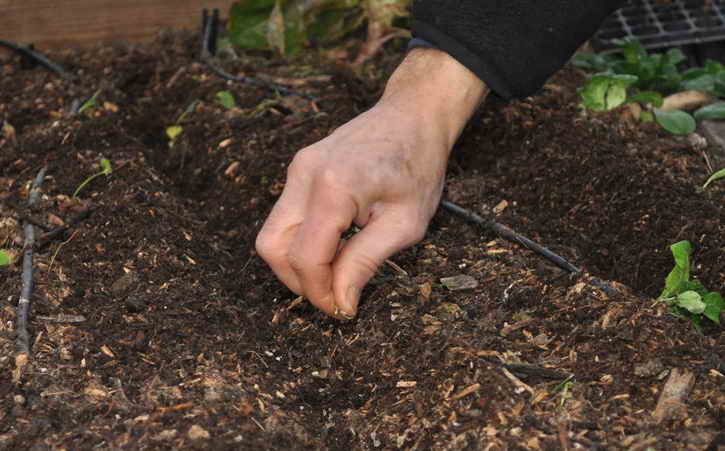

The lightness and looseness of the soil increases the deepening of the vegetable and contributes to the formation of an even root. The addition of peat, sand, rotted manure or compost will help to reduce the density of the earth.
Apply manure under the predecessor - this will eliminate the formation of crooked vegetables.
Fertilization
Controlling the acidity level allows you to adjust the taste properties of the crop. The optimum Ph level for carrots is 6-7. To create the ideal environment, it is recommended:
- add lime, dolomite flour, chalk or ash to deoxidize the soil (1 item / 1 m2);
- make 2 tbsp. l. superphosphate.
The activities are best performed in the fall, since rain and snow distribute the trace elements contained in the fertilizers. Organic matter is added to the soil in the spring.
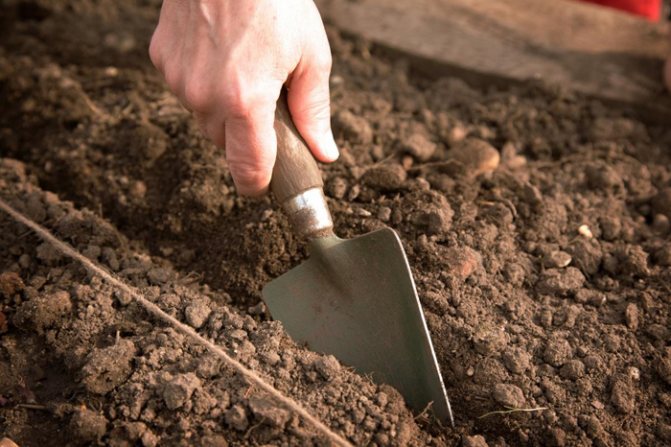

Determination of soil type
To find out what kind of soil is on the site, you need to take a handful of earth and soften it to a state of gruel, and then roll a ball:
- sandstones crumble in hands;
- sandy stones are rolled into a rope;
- any figure can be molded from clay;
- loams roll only to a spherical shape.
The dryness of the soil is checked by adding 8 liters of water to an un-dug area of 50x70 cm.After the water disappears, gray spots form on the dry and salty ground.
Planting seeds


Before sowing, grooves are made in the garden using a thin board (slats). The use of a slat is preferable as the ground is crushed to provide better seed-to-soil contact.
The depth of furrows for autumn sowing of carrots is 3-3.5 cm, for spring sowing - 2-2.5 cm.The distance between shoots should be at least 5 cm.But since carrot seeds are very small, they are often planted denser and then thinned out sprouts.
Landing includes the following steps:
- creation of seed furrows;
- watering furrows;
- sowing seeds into grooves;
- sprinkling seed material with earth or humus (2 cm);
- easy tamping (slapping) the surface of the garden;
- watering from a watering can.


Seeds sprout amicably in moist soil. If the weather is dry, the entire ridge is well watered before planting.
Vitamins found in carrots


Carrots are an excellent source of large amounts of vitamins and minerals.
- phytoene;
- phytofluene;
- lycopene;
- carotenes;
- essential oils;
- B vitamins;
- vitamin D;
- pantothenic and ascorbic acids;
- anthocyanins;
- umberylsfron;
- lysine;
- flavnoids;
- ornithine;
- histidine;
- cysteine;
- asparagine;
- threonine;
- proline;
- methionine;
- calcium;
- zinc;
- magnesium;
- selenium;
- phosphorus.
In terms of carotene content, it surpasses all vegetables and fruits with the exception of sea buckthorn. It is this element that gives it its orange color. Moreover, it is available at any time of the year at a low cost, which makes carrots an indispensable product on any table.
Carrots are also high in glucose, which is why they taste so sweet. It also contains starch, pectins, fiber.
The most useful will be a ripe carrot, it is in it that all the nutrients are contained in the maximum amount.
Carrot care
Carrot beds do not require much care. But in order to get a high yield, they need to be cleared of weeds and watered, especially in the absence of rain. Carrot pest control is of great importance.
Weeding the beds
Carrots grow slower than weeds. The first shoots of weed grass appear before carrot shoots. Weeds are removed when quinoa, wormwood, bumble and other herbs reach a height of 1.5-2.5 cm.


Weed weeding is combined with carrot thinning, if necessary. During the summer, you need to remove weeds from carrot ridges 3-4 times. If this is not done, the roots will not reach the desired length and thickness.
Watering carrots
The water must feed all of the growing root crop. Poor watering will result in fruit that is thickened at the top and thinner at the bottom. The flesh of the carrot will be sluggish and may have a bitter taste.
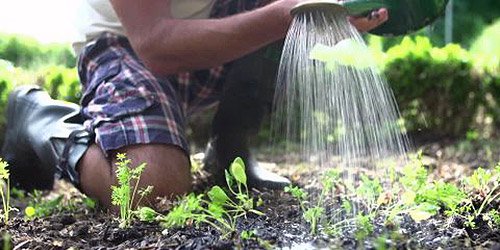

In mid-July, when the carrot root crop is formed, irrigation water should seep into the soil by 30-35 cm. One plentiful watering will provide the carrot bed with water for 5-7 days.
Features and types for open ground
Among the hybrids intended for open ground, varieties of early, middle and late ripening types are distinguished.
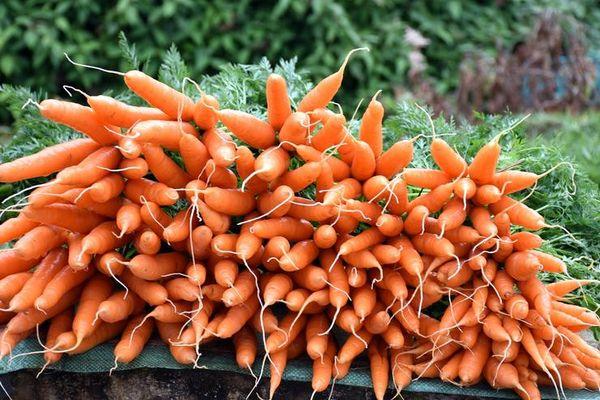

Early
Early ripening is ripening that occurs no later than 100 days after planting. Early types are not suitable for long-term storage. They are usually sweet and juicy.
Fun F1
A hybrid bred by breeders of the West Siberian District. From the moment of sowing to harvesting, it takes from 90 to 100 days.
The pulp is dense, juicy, sweet. There are almost no voids in the middle. Suitable for making juices, desserts, additives to sweet dishes. The weight of one piece reaches 200 grams, the length reaches 20 centimeters.
See also
Description of purple carrots, its composition, use
To read


Tuchon
The sowing-to-harvest period is 75-80 days. Rich orange roots grow up to 20 centimeters, up to 150 grams. The variety is distinguished by high yield rates.
Lady
Cylindrical fruits grow smooth and flawless. Length reaches 20 centimeters, weight - up to 200 grams. The variety adapts to different climatic conditions, with the observance of the rules for care, it shows high yields.


Lagoon F1
Ripening period - from 80 to 90 days. The shape of the vegetables is regular, oval. Vegetables weight - 150-200 grams, length - 20 centimeters. The variety is known among summer residents for its ability to adapt to different temperature conditions.
Sugar finger
Fruit color ranges from yellow to yellow-orange. The shape is a cylinder, no dents or flaws. The variety has a minimum ripening period, harvesting is possible on the 65th day.
Alenka
Small fruits, up to 15 centimeters long, conical in shape, with a blunt end, reach 100-150 grams. The taste is noted as juicy, sweet, with a lot of juice.
Caramel
The name was chosen due to the fact that the variety has a sugar taste and is used for baby food.
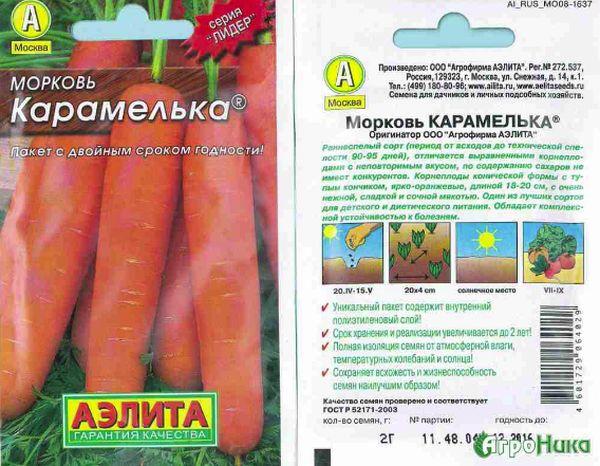

The length reaches 15 centimeters, the ends of the carrots are blunt. The skin is thin and easy to clean. The hybrid is highly resistant to pests and infestations.
Beloved
This is one of the varieties that, despite early ripening, can be stored for a long time. Has a sweet taste, juicy. Due to the high content of carotene, it has a bright orange hue.
Amsterdam
This is a Dutch hybrid that ripens in 80-85 days. The shape of the fruit is cylindrical, with a blunt end. Grows up to 18 centimeters, 150 grams. Differs in high yields, resistant to flowering, vegetables do not crack during storage.
Dutch woman
Technical ripeness occurs 90-100 days. Many gardeners attribute it to mid-season varieties. The hybrid is bred with genetic resistance to yellowness, is not susceptible to infections and pests. Medium carrots are 16-18 centimeters long. The hybrid needs loamy soils to grow.
Dragon
The variety was bred in America, the peculiarity of the fruits lies in the purple color. The pulp inside the fruit remains the usual orange color. Cone-shaped fruits grow up to 25 centimeters, thin tips. By taste, carrots are characterized as sweet and spicy.


Nandrin
The peculiarity of the hybrid is stable yield estimates. It is grown on the territory of farms, where income depends on the yield. Carrots were developed by Dutch scientists. Fruit weight can reach 300 grams, length - about 15-20 centimeters. The pulp is orange, juicy, suitable for any dishes and preparations.
Boltex
The hybrid is in demand in regions where pre-winter sowing technology is practiced. The variety is stable, technical ripeness occurs in late spring or early summer. Vegetables grow up to 20 centimeters long and are moderately orange in color.
Shantane
A variety of French origin. The fruits are large and even, with an average weight of 200 grams and a length of about 20 centimeters. The pulp is juicy, the cores do not contain empty spaces. Carrots are suitable for cultivation in industrial areas and in private plots.
Average
Hybrids of medium ripeness begin to ripen at 100-120 days. The peculiarity of the varieties is that the seedlings are in no hurry to appear. This property can alert summer residents. In fact, medium carrots combine several characteristics of early hybrids and can be stored longer due to their denser structure.
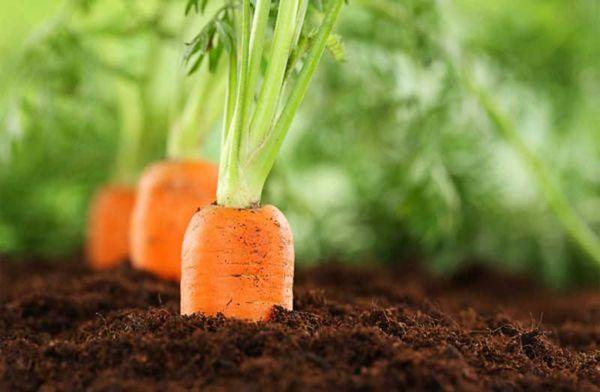

Honey
Sweet juicy hybrid with a period from sowing to harvesting of roots about 80-90 days. The color is deep orange, which indicates an increased content of the element carotene. The name suggests that carrots are in demand among connoisseurs of the sweet type of carrot.
Top type
The variety is known for the fact that the fruits do not crack after harvest, are prone to long-term savings, and have excellent taste characteristics. They grow up to 25 centimeters and weigh about 250 grams.
Vitamin
The bright orange roots can grow up to 20 centimeters. The yield is characterized as high. The vegetable reaches technical ripeness on day 110. According to research by specialists, vegetables have a high level of B vitamins.
Carrots are well stored, do not crack during transportation.
Olympian F1
The shape of the carrots is conical; with a weight of about 130 grams, they stretch up to 25 centimeters. Dense in structure, juicy pulp with thickened rind is suitable for blanks. Consumed fresh and suitable for storage. The variety is not recommended for juicing, as the liquid content is reduced.


Perfection
Smooth, thick cylindrical carrots ripen in 150 days. When dense, the peel has a juicy pulp. The cores are not prone to void formation. The fruits stretch to almost 30 centimeters and weigh 130 grams.
Moe
Medium late variety with uneven ripening period. Known for its consistent yields. The fruits are generally cone-shaped. Stored well in ventilated areas.
Losinoostrovskaya
This hybrid is popular for its high carotene content. It is often used for landings before winter. It tolerates frost and has good germination. Vegetables grow up to 17 centimeters and weigh about 130-150 grams.
Nantes
Carrots of this variety are called the best among the mid-season varieties. Technical ripeness varies from 90 to 105 days. The mass of the root crop is considered average, the weight reaches 150 grams, the length is 17-18 centimeters. The diameter of the fruit is 4.5-5.5 centimeters. Root vegetables have a delicate taste, the core is small, without voids.Carrots are suitable for preparation of preparations, desserts, storage.
Gourmet
Fruits are dense, with juicy pulp, average juice production. The weight of an average vegetable can reach 200 grams, the length of a carrot is about 25 centimeters.
See also
Description of Nantes carrots, growing rules and care
To read


Moscow winter
The hybrid is sown before winter. It has high yields. Designed to be taken fresh in autumn and winter. Stored for a long period.
Samson
Universal variety, ripens in 120 days, resistant to infestations. Does not show a tendency to flowering. Does not crack during storage.
Incomparable
A cone-shaped hybrid, the diameter of carrots reaches 5-6 centimeters. The length of the fruit is 25 centimeters, with a weight of up to 150 grams. Differs in good keeping quality.
Redcore
American variety with a high carotene content, ripens 120 days from sowing. The shape is cylindrical, with a thickening towards the aerial part. Recommended for use in autumn and winter.
Carini
The conical shape of the fruit weighing up to 130 grams, up to 17 centimeters long. They are used for storage due to the fact that the variety retains its useful qualities and structure density for a long period.
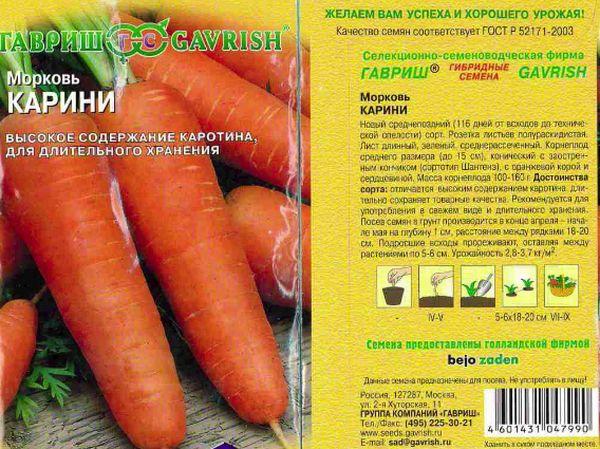

Late
Late ripe carrots are suitable for longer storage. These include varieties with a growing season of more than 110 days.
Bayadere
Large fruits reaching 30 centimeters. Harvesting is carried out 140 days after sowing.
Vita Longa
A Dutch variety that is harvested 150 days after sowing. Root crops are large, can grow up to 300 grams. The conical shape with a blunt end is convenient to use for preparing dishes and workpieces.
Red giant
The diameter of vegetables reaches 7-8 centimeters, this is a variety of short and thick types of shape. Dense carrots can be stored in cool rooms for about 6 months.
Red without a core
Carrots are large-fruited, with a dense structure, narrow and thin core. It grows in any soil, it is resistant to infestations and pests.


Flyovi
The hybrid is harvested on day 175. The shape of the fruit is short, conical, with a dense, hard structure. Taste - sweet and spicy, with little juicing during cooking.
Karlena
A high-yielding variety, ripens 130-140 days from sowing. The ends of the fruits are rounded, reaching 180 grams in weight.
Autumn queen
The conical shape of carrots has a thickening in the aerial part. Weight is 150-180 grams with a length of 20 to 25 centimeters. The high yield of the variety is due to its ability to adapt to any conditions. This hybrid is especially in demand in areas where the main harvest is used to be done in the fall. The queen of autumn can be stored for 3-5 months, subject to the basic conditions.
F1 cascade
Small cone-shaped fruits reach an average weight of 70 to 120 grams. The hybrid has good keeping quality. He is loved for the fact that he is able to be stored for 6 months without losing its qualities. Recommended for cultivation in the central region of the country.


The emperor
With a high carotene content, the variety has a small core. The pulp is firm and juicy. The shape is conical, weight is from 90 to 110 grams, length is 20 centimeters. It is grown on loose light soils with the addition of potash fertilizers.
Fancy
Among the variety of species, there are multi-colored fruits. Many are in demand along with the usual bright orange vegetables. The disadvantages of unusual colored varieties are considered their low storage capacity. They are not subject to decay, but dry out quickly and lose their taste.
White
This variety is not popular, although it has a unique vitamin composition. In the absence of carotene, the composition is rich in B vitamins.
Red
The element lycopene is responsible for the color of this variety.The carotene content is also high in red hybrids. They are suitable for preparing side dishes, used as auxiliary ingredients. The taste of carrots allows it to be used in dietary nutrition.
Black
This vegetable crop is not in demand in Russia. It is grown in the Mediterranean. Black fruits reach 15 centimeters long and weigh 200 grams. The root vegetable is black on the outside, but the flesh is exceptionally white on the inside.
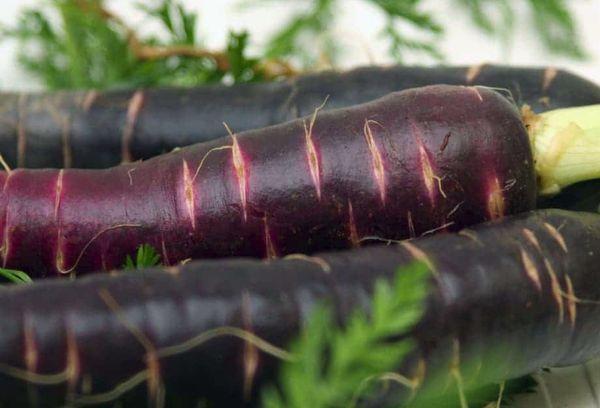

Vegetables of this variety are divided into early, medium and late. Late-ripening varieties are suitable for long-term storage.
Yellow
The ripening period for this variety reaches 115 days. The shape of the fruit is yellow, most often conical. Average weight - 130 grams, average length - 70-90 centimeters. It has low keeping rates, is not used for storage and transportation, therefore it is used mainly fresh.
Fodder varieties
These varieties are mixed with herbs, tops, and other additional components and used for feed for pets and birds. Their demand depends on the juiciness, nutritional value and structure of forage types.
Advantages of fodder carrots in agriculture:
- the possibility of early sowing;
- resistance to return frost;
- the ability to carry transportation and be stored for a long time.
From the variety of varieties, farmers distinguish white fodder carrots. The varieties of this variety have high yields. Red fodder carrots are rich in carotene, suitable for feeding young animals and birds.
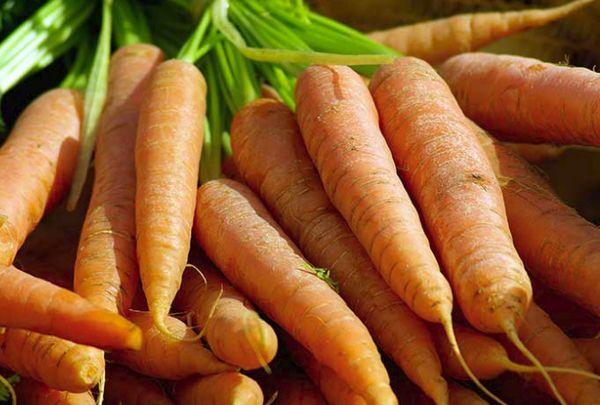

Non-standard varieties of carrots
We are used to the fact that carrots are an oblong root vegetable of warm orange or orange color. This is perceived as an indisputable fact. What is the surprise of inveterate summer residents when they see a purple, red, radish-like carrot.
There are white and pink carrots. At the same time, in terms of taste, the root crop is not inferior to the standard orange or yellow analogue. Growing an unusual carrot in your garden is no more difficult than an ordinary vegetable.
What varieties to choose to grow a custom vegetable? If you want to get a purple carrot with an orange core, then buy a variety of Dragon or Purple Elixir F1.
Many varieties of custom carrots can be found in the store. There are small vegetables that resemble a radish. Choose which carrot to grow, based on the calculations of the yield and the amount of time you can spend on caring for the beds.
The origin of white carrots
It is believed that the birthplace of the plant is Afghanistan. Other sources also mention Iran and northern India (present-day Pakistan). The progenitor of all varieties of this vegetable is wild-growing carrots. It has been cultivated as an economic crop for about 4000 years. Surprisingly, at first it was grown for the sake of fragrant tops and seeds. The annals of history mention the nutritional use of root crops only from the 1st century AD. e.
But only in the XIV-XV centuries, white carrots, along with orange and red varieties, penetrated into Europe. Germany, England, France, the Netherlands have become interested in culture. Since the root vegetables had a bitter taste, they began to be grown as livestock feed.
It was only in the 17th century that the Dutch developed a sugar variety suitable for use in cooking. And modern varieties of white carrots were obtained quite recently, in the 20th century. They were bred from yellow plant species native to the Middle East and South Asia.
Choosing a place for the beds
Carrot beds should be warmed up by the rays of the sun all daylight hours. In conditions of shade and partial shade, the root crop will be thin and weak, and the carrot tops, on the contrary, will be abundant. Carrot beds should not shade bushes, tree foliage, tall garden plants and flowers. The soil must pass water well.
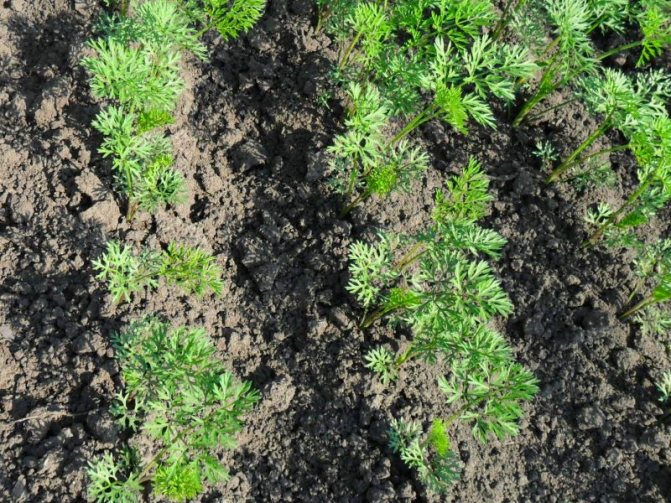

Carrots grow poorly after parsnips, dill, celery and parsley.The harvest will be good if the carrots are planted in the places of tomato and cucumber ridges, potatoes, peas, beans, beans, onions, cabbage, garlic.

